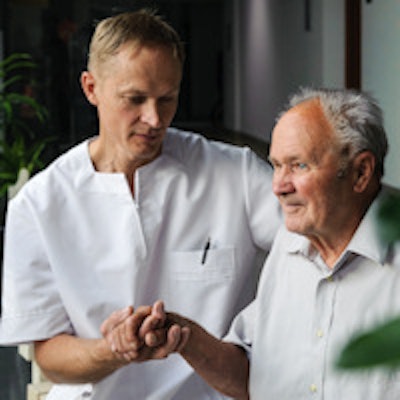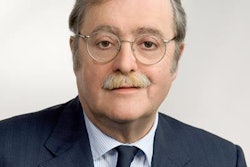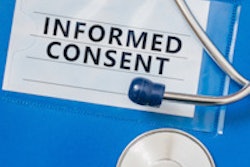
Healthcare systems around the world face ever-growing economic pressures, forcing doctors and other staff to become more efficient and cost-effective. Scanning and reporting of studies is sometimes planned like a factory line.
Where do anxious patients and their concerned relatives or friends find due consideration? How does it feel to be "on the other side"? Maybe you have time to pause briefly and read this thought-provoking interview with Dr. Lorenzo Derchi, who recently found himself accompanying a close relative to hospital. Thinking more about patient may make you less efficient sometimes, but definitely more human and understanding -- qualities every doctor should have.
 Dr. Lorenzo E. Derchi is professor of radiology at the faculty of medicine at the University of Genoa and chair
Dr. Lorenzo E. Derchi is professor of radiology at the faculty of medicine at the University of Genoa and chairof emergency radiology at the Hospital San Martino in Genoa, Italy. He is the current chair of the ESR Publications Committee.
ECR Today: Have you ever had a personal experience as a patient, or as a relative or friend of a patient, which made you change your own practice? How does it feel to be on the "other side" when you are not in charge?
Lorenzo Derchi: I recently had a close relative who was hospitalized for acute pancreatitis (luckily without complications). She was admitted to the hospital where I work, and then I had the advantage of being well known by both doctors and nurses working in that ward. However, the main problem I had was the difficulty of managing my anxiety, as well of that of all the other members of the family, about what was happening.
I can imagine what may be in the mind of someone who does not know anyone. The wish to immediately know about the results of examinations, about what the doctors thought of any new change, for better or worse, was always there, even though I know that examinations take time to be performed or, in case of radiological ones, to be read. Concern about how care was taken of our beloved one was another problem; when a venous line got blocked and a peripheral vein got broken, I considered it to be a "mistake," even though I know these problems may have a variety of causes (and many due to the patient) and also happen in radiology.
I cannot say if this experience changed my daily practice. What I know is that I am now more sure that informed patients deal better with their problems; that I have to try to provide my reports in as timely a fashion as possible; and that any time spent talking with a patient is time well spent (and I am pretty sure that the topic of the conversation does not matter too much).
Awareness of what radiologists and radiographers do is generally deemed poor among patients and the public. They can probably relate better to the doctors they see on daily ward rounds than to the radiologist who makes a diagnosis based on their images. How can we raise the profile of our profession?
Patients who come to the radiology department do not see the radiologists working there. They usually meet a nurse or a technician, depending on which examination they have to do, but almost never meet (or even see) a physician radiologist. Exceptions to this rule are interventional radiology and, in many countries, also ultrasonography.
To raise the profile of our discipline, we have first to become visible. This can happen either before or after the examination. When the patient can be met before the study such as, for instance, when a signature for informed consent is needed, we should first introduce ourselves as "the doctor who will provide interpretation of the images that come out from the machine," then give a short explanation of the procedure, as well as of its risks and benefits.
Some practices provide postprocedural services, involving discussion of the results of the study directly with the patient, either in person or on the phone, usually at established time slots during the day. Other ways may be "invented," but we have to become visible.
There must be a change in the criteria of evaluation of a department of radiology. Not only the time from order to performance of studies, the number of examinations performed, and the revenues from them, but also something less tangible -- things such as the quality of the relationships with patients.
What communication practices make a difference when you feel scared and vulnerable as a patient or relative?
During my experience as a close relative of a patient, I had problems talking with the nurses in the ward. They were quite busy and they were few, always running around, often very tired. I was not at ease with stopping them with my questions and distracting them from their work. It is a matter of time. As a matter of fact, these days, the organization of healthcare systems gives too much attention to efficiency.
Everything is (or this seems the goal to reach) organized as in a factory. In order to ensure that good communication develops between patients and personnel in the hospitals, it is not sufficient to campaign for a friendly welcome or a warm smile from the personnel side. It is the whole organization that needs to be reconsidered in order to allow room for the possibility of relationships among doctors, technicians, nurses, patients, and their relatives that are not only "professional," but also "human."
How can misunderstandings arise? Are there common complaints that could be avoided? What would you advise when you think a patient may be likely to complain?
Misunderstandings arise when hospital workers do not understand the needs of their patients and, vice versa, when patients do not understand the problems we have in our work. It is always a bidirectional relationship; any radiological examination has to be a "dialogue" between the radiologist and their patient.
On our side, we have to regard each patient as a human being and not simply as a clinical case or a number in the day's worklist. Patients have to remember that we are there to do a job and do it well.
I work in emergency and in my environment, most complaints are due to the long times some patients have to wait before having their examinations performed. In emergency, in fact, patients are examined according to their severity scores and not to the time of their arrival. In my experience, a periodic look at the waiting room, together with an explanation of this concept to the people sitting there, is a good way to reduce the number of complaints on this topic.
These days many patients come prepared and have researched their symptoms and presumed diagnosis online. Which innovative ways could you advise to consider keeping patients better informed and giving them good quality information they can understand?
There is a lot about medical topics on the Internet. Many hospitals have a website providing information about their services and many radiology departments have pages describing the examinations they perform, what they are, and how to be prepared for them. This can be greatly helpful to the patients. However, it is not easy to write this information in a language that is understandable to all.
A number of papers reviewing the information provided on the websites of many scientific societies have shown that those dedicated to patients are usually written in a way that can be difficult to follow or to understand by the general public. The European Society of Radiology (ESR) has an additional problem, because in Europe we have many different languages; we cannot expect that English will be understood by all European citizens. This is the reason why it has been decided to put, in the section of our website dedicated to patients, links to hospitals in different nations or to national radiological societies where such information is presented in the many languages spoken in Europe.
I have also seen that, in some cases, examinations can even be booked online and reports can be downloaded from home by the patients after entering the hospital information system via credentials given at the time of the study. This may raise security and privacy issues, but these will surely be overcome and this is probably the way toward an even more helpful use of information technology in our relationships with patients.
More and more hospitals and professional bodies consider patient representation. When and why is this important? How can patient representatives be found? Who is suitable to fulfill this role?
Because the relationships between doctors and patients are bidirectional, the role of organizations representing patients within the hospital is quite important, at all levels. Their point of view is different from that of the personnel working there. They can identify and bring to our attention problems we do not see and this can be quite useful to help us improve the quality of our services. Furthermore, patients not only have rights; they also have duties when in the hospital.
Patient organizations acknowledge this and, coming from their side, rules of behavior are more easily accepted by patients. It is not easy to answer the question about who is suited to be a good patient representative. In my experience, I have seen that some patients who have gone through a long illness and have in the end recovered have the willingness and the capability to enter this field. They are knowledgeable about the problems they encountered and are then able to help both other patients and the personnel dealing with them. In my hospital, there are even some doctors who, after retirement, have become active within patient representative organizations.
Which departmental projects or audits related to the patient's perspective, communication with patients, patient information, etc., could you think of that may have a direct impact on quality improvement? How can trainees or senior staff get involved, with mutual benefit for doctors and patients?
We had a number of research initiatives in the field of the relationships between patients and hospital personnel. We have used interviews and questionnaires to assess the quality of the "professional" and "human" relations with the personnel in the radiology department; we have tried to analyze if patients know that the diagnosis does not appear on the monitors of our workstations but is the result of how a study is planned and performed and of a process of image interpretation; and we have tried to understand the patients' knowledge of the respective roles of the radiologist and the technician.
The results are that "professional" relationships are usually correct, but the contact with patients is cold and impersonal; that most patients rely on the machines and even do not know that the diagnosis is the result of the interpretation of the images from a radiologist; that our role and that of the technician are not perceived as different. We both, in most cases, are considered by patients as the photographers who only have to push a button to obtain their picture.
Both juniors and senior staff were involved in the collection and discussion of the data. What we learned is that we are more or less "invisible" to the patients and that, often, we are not perceived by them as physicians. We have to work hard to make our role recognized by them. Furthermore, we measured how often patients ask about the results of their examination immediately after having it done.
It was found that patients asked more frequently after a study during which there was a dialogue with the examining doctor. Again, it is a bidirectional relationship: if we, as physicians, interact with patients, they will interact with us. This is the key factor in making patients fully appreciate the crucial role of the radiologist in their diagnosis and treatment.
Interview conducted by Dr. Christiane Nyhsen, consultant radiologist at Sunderland Royal Hospital, U.K.; member of the editorial advisory board of AuntMinnieEurope.com; and former chairperson of the ESR Radiology Trainees Forum.
Originally published in ECR Today on 4 March 2016.
Copyright © 2016 European Society of Radiology



















